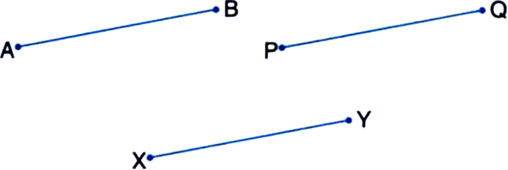
Consider two ‘postulates’ given below:
(i) Given any two distinct points A and B, there exists a third point C which is in between A and B.
(ii) There exist at least three points that are not on the same line.
Do these postulates contain any undefined terms ? Are these postulates consistent? Do they follow from Euclid’s postulates ? Explain.
Yes! These postulates contain two undefined terms: Point and Line.
Yes! These postulates are consistent because they deal with two different situations (i) say that given two points A and B, there is a point C lying on the line in between them, (ii) say that given A and B, we can take C not lying on the line through A and B. These ‘postulates’ do not follow from Euclid’s postulates however, they follow from Axiom 5.1.
Give a definition for each of the following terms. Are there other terms that need to be defined first ? What are they, and how might you define them?
(i) parallel lines (ii) perpendicular lines
(iii) line segment (iv) radius of a circle
(v) square.
(i) Parallel lines. Lines which do not intersect anywhere are called parallel lines.
(ii) Perpendicular lines. Two lines which are at a right angle to each other are called perpendicular lines.
(iii) Line segment. It is a terminated line.
(iv) Radius. The length of the line-segment joining the centre of a circle to any point on its circumference is called its radius.
(v) Square. A quadrilateral with all the four sides equal and all the four angles of measure 90° each is called a square.

From (1) and (2),
AC = AD.
| Things which are equal to the same thing are equal to one another


(i) Only one line can pass through a single point.
(ii) There are an infinite number of lines which pass through two distinct points.
(iii) A terminated line can be produced indefinitely on both the sides.
(iv) If two circles are equal, then their radii are equal.
(v) In figure, if AB = PQ and PQ = XY, then AB = XY.
(i) False. This can be seen usually.
(ii) False. This contradicts Axiom 5.1.
(iii) True. Postulate 2.
(iv) True. If we superimpose the region bounded by one circle on the other, then they coincide. So, their centres and boundaries coincide therefore, their radii will coincide.
(v) True. The first Axiom of Euclid.
